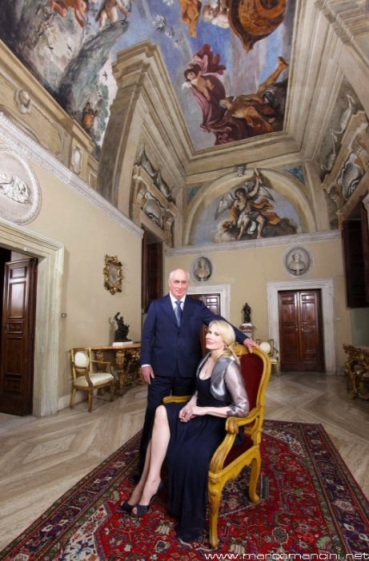About the Archivio Boncompagni Ludovisi
A Prologue
The Archivio Digitale Boncompagni Ludovisi is a collaboration that T. Corey Brennan (professor, Dept. of Classics, Rutgers University) while Andrew W. Mellon Professor in the American Academy in Rome (AAR) for 2009-2012 initiated with the head of the Boncompagni Ludovisi family, †HSH Prince Nicolò Boncompagni Ludovisi, Principe di Piombino XI, and his wife HSH Princess Rita Boncompagni Ludovisi, Principessa di Piombino XI. This weblog features some of the results of this initiative, with posts highlighting new discoveries on the social, cultural, intellectual and political history of the Boncompagni, Ludovisi, and Boncompagni Ludovisi families from the tenth century AD to the present.
One key attribute of this project is that—in addition to an international working group of noted specialists in the fields of history, art history and conservation—the Prince and Princess Boncompagni Ludovisi have a long history as energetic collaborators in the creation and diffusion of the newly created knowledge that is rapidly emerging from the massive collection of important documents and artifacts in their possession. Another significant feature is that, thanks to the support of Rutgers—New Brunswick Chancellor Richard L. Edwards, a generous grant of Rutgers University Strategic Funds, and also crucial funding from Rutgers’ School of Arts & Sciences, we have been able both to digitize the whole of the Boncompagni Ludovisi archive that remains in private hands, and video- and photodocument many (if not most) of the family’s other cultural treasures.
The †Prince and Princess long resided in Rome at the Casino dell’Aurora and the Princess (who lives in the Casino Aurora in perpetuity) is currently engaged in a major renovation effort of the building and its grounds, and their rich artwork (which includes masterpiece frescoes by Guercino and other leading lights of the 17th century Bolognese school, as well as the only Caravaggio oil painting on plaster).
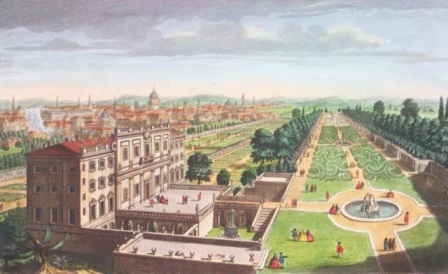
A view of the Villa Ludovisi. Watercolored etching (dated 1818) of an original (ca. 1750) by Thomas Bowles, showing the Palazzo Grande and adjacent gardens
For short biographies of Prince and Princess Boncompagni Ludovisi, their titles and their respective ancestries, see here. Of Italian noble families, the Boncompagni Ludovisi are the only Princes of the Holy Roman Empire who are Sovereign as well. The Boncompagni Ludovisi show in their family tree two popes (Gregory XIII Boncompagni, 1572-1585), who is direct ancestor of Prince Nicolò, and Gregory XV Ludovisi, 1621-1623), and numerous cardinals, in addition to many other men and women of high distinction, in fields that range from statesmanship to the sciences, across a full millennium.
A (very) short history of the Villa Ludovisi in Rome
From 1622 to 1886 the Ludovisi and then the Boncompagni Ludovisi created and maintained the largest (in its final form, 89.6 acres) and most magnificent private residence within the walls of Rome, the Villa Ludovisi. The Villa, the associated Gardens, and their many art treasures attracted the admiration of numerous visitors, including John Evelyn (1644), Grangier De Liverdis (1660-1661), and then Goethe (1787), Stendhal (1828), Nikolaj Gogol (1838-1842), Nathaniel Hawthorne (1858), Frances Elliot (1854, reworked 1871), Henry James (first in 1873)—to name just some of the literary figures.

1650 view of the Villa Ludovisi, centered on the Casino Aurora, by Nicolaes Lauwers
Important plans or depictions of the Villa Ludovisi were produced by Maggi (1625), Silvestre (1650), Lauwers (1650), Falda (1683), Piranesi (1741-1748), Vasi (1747-1761), Vernet (1749), Hubert (1764), Nolli (1778, detail), and others.
After the dissolution in 1886 of the Villa Ludovisi (with the exception of the Casino Aurora, and the Palazzo Grande and its immediate area), the family went on to build the last truly massive private residence in Rome, what is now known as the Palazzo Margherita on Via Veneto, which today houses the US Embassy (as well as a significant portion of the historic Ludovisi collection of sculpture).

The Villa Aurora in its original setting in the Ludovisi Gardens, ca. 1885. Photo from set of ca. 160. Collection of HSH Prince Nicolò and HSH Princess Rita Boncompagni Ludovisi, Rome.
The new archival materials from the Casino Aurora
The current digital project originates from the recent (July 2010) retrieval by Princess Rita Boncompagni Ludovisi from family properties of a sizable set of documents. The set contains many dozens of boxes containing numerous files and bundles, dating principally from the 1400s (with some earlier items) through the 1900s. A rough estimate puts the archival collection at perhaps 150,000 pages. Virtually all this material has long been inaccessible to the scholarly world. An overwhelming proportion of the individual paper leaves, regardless of age, are in near-pristine condition, thanks to their protection from light and handling. (It has been estimated that just 5% of the whole pose a conservation risk.) One remarkable attribute of the collection is that, where relevant, seals and other anti-tampering devices have been carefully preserved.
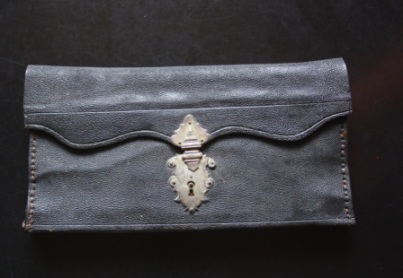
Purse (locked since 1734) belonging to Eleonora Boncompagni Ludovisi (1686-1745), who reigned as Princess of Piombino from 1733-1745. Collection of HSH Prince Nicolò and HSH Princess Rita Boncompagni Ludovisi, Rome.
This important discovery of many thousands of individual archival items adds significant complementary materials to those known from the “Fond Archivio Boncompagni Ludovisi“, presently held by the Archivio Secreto Vaticano. That large collection came to the Vatican after a donation by Prince Francesco Boncompagni Ludovisi (grandfather of Prince Nicolò Boncompagni Ludovisi) in 1947, with full inventory started only in 2001 and published in five large volumes in 2008, by dott. Gianni Venditti.

Documents recording honors granted in 1582 by King Philip II of Spain to Giacomo Boncompagni (1548-1612), son of Ugo Boncompagni = Pope Gregory XIII. Collection of HSH Prince Nicolò and HSH Princess Rita Boncompagni Ludovisi, Rome.
The bulk of the rediscovered materials originally belonged to the private Archivio Boncompagni Ludovisi that in its developed form was located in the family’s Palazzo at Via della Scrofa, 39 in Rome. The relevant rooms for the archive occupied approximately 100 square meters. A resystematization of the mid 19th century arranged the family’s materials into 31 large cabinets (armadi) housing over one thousand classes of documents (protocolli). In turn, one protocollo sometimes contained upwards of 150 individual subcategories (numeri). These ‘numeri‘ might represent one item (of any length) or many.
Preliminary investgation of the new archival finds suggests that they largely correspond to the ca. 65 protocolli that are missing from the Archivio Segreto Vaticano holdings, or to individual numeri listed as “lost” within otherwise complete protocolli in the ASV collection. The appearance of many items of high historical value among the new finds (e.g., wills, family trees, letters from sovereigns) suggests that this is not material separated by chance when Francesco Boncompagni Ludovisi made his gift to the Vatican in 1947.
It should be noted that among the new finds there is also a significant number of family items (photographs, other documents, ranging from the personal to the fiscal) from the later 19th and first half of the 20th century that never will have formed a part of the formal Archivio Boncompagni Ludovisi.
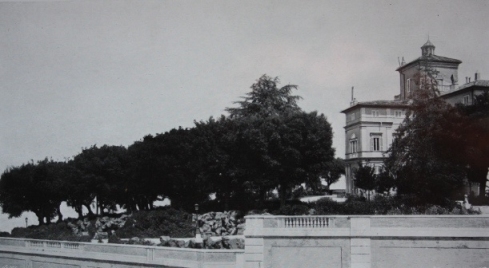
The Villa Aurora as it appeared in 1904. Collection of HSH Prince Nicolò and HSH Princess Rita Boncompagni Ludovisi, Rome.
What do the new finds from the Archivio Boncompagni Ludovisi say?
Though the new Boncompagni Ludovisi documents have yet to be fully inventoried—much less studied—even a quite preliminary investigation of a small sample of the whole suggests that they will throw much further light on many aspects of the history of the west.
As in the much larger “Fond Boncompagni-Ludovisi” in the Vatican Secret Archives, documents pertaining to the administration of the patrimony of the family play an important role, as well as documents of enormous interest for the history of the Church, the Italian Renaissance and Baroque, and the historical period before and immediately after Italy’s unification.

Autograph declaration of Ugo Boncompagni = Pope Gregory XIII of his paternity of son Giacomo, 22 December 1552. Collection of HSH Prince Nicolò and HSH Princess Rita Boncompagni Ludovisi, Rome.
But in the new finds there is also exquisite documentation of the ancient titles and prerogatives of the family; the management of artwork and properties (with much on the circumstances of the “lottizzazione” ca. 1885 of the magnificent Ludovisi Gardens); but especially the personalities of such major figures as Pope Gregory XIII (=Ugo Boncompagni, 1502-1585), Pope Gregory XV (=Alessandro Ludovisi, 1554-1623), Cardinal Ludovico Ludovisi (1595-1632), Ippolita Ludovisi (1663-1733, Princess of Piombino 1701-1733), Eleonora Boncompagni Ludovisi (1686-1745, Princess of Piombino 1733-1745), and then through Francesco Boncompagni Ludovisi, Governor of Rome (1926-1935) but later an invaluable aid to Allied forces in Italy during and after the Second World War.
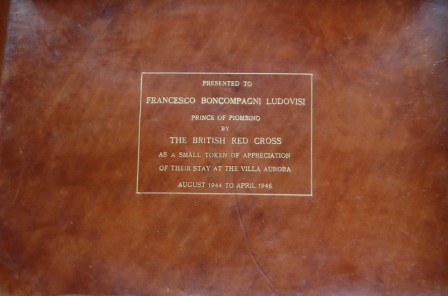
Leather document box at Villa Aurora, presented by British Red Cross to Francesco Boncompagni Ludovisi, Prince of Piombino X, 1946. Collection of HSH Prince Nicolò and HSH Princess Rita Boncompagni Ludovisi, Rome.
Another invaluable component of the Boncompagni Ludovisi collection is a large set of unpublished monographs by Giuseppe Felici. Felici was the author of the authoritative Villa Ludovisi in Roma (1952). But much earlier he served as the learned tutor of the young Prince Francesco Boncompagni Ludovisi, and also served for many decades as archivist of the family collection before the bulk of it was transferred to the Vatican. In the space of some 12 years (1940-1952) in extremely challenging conditions, Felici somehow managed to write 15 detailed studies in 48 volumes on family history from ca. 1550 to 1815. Each of these studies Felici based quite closely on the unified archives, with detailed citation of original sources throughout. In some instances, to illustrate his scholarly points, he physically inserts the original documents into his monographs. Taken as a whole, Felici’s efforts in which he shapes important portions of the Archivio Boncompagni Ludovisi into a historical narrative represent a major and unrecognized contribution to the synoptic understanding of the massive family archive, while it still remained whole.
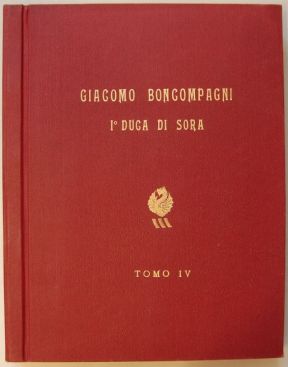
One of 15 unpublished titles (in 49 volumes, composed 1940-1952) in which the family archivist Giuseppe Felici explores Boncompagni Ludovisi history. Collection of HSH Prince Nicolò and HSH Princess Rita Boncompagni Ludovisi, Rome.
Collaborative initiatives on the history of the Boncompagni Ludovisi
Scholars in addition to T. Corey Brennan (Professor of Classics, Rutgers University) who are presently working with the material include Jana Dambrogio (FAAR’08), Thomas F. Peterson (1957) Conservator at MIT Libraries; Caroline Castiglione, Professor of Italian Studies and History at Brown University; Bernard Frischer (FAAR ’76, RAAR ’97), Professor of Informatics at Indiana University; Claudia La Malfa, American University of Rome; and Valeria Brunori, Cultural Heritage Curator at the US Embassy, Rome. Other scholars involved in the enterprise include or have included †Theodore K. Rabb (Professor Emeritus of History at Princeton University); Richard L. Kagan (Arthur O. Lovejoy Professor of History, Johns Hopkins University); Munro Price (Professor of Modern European History, University of Bradford); and Anthony Majanlahti (a historian and author based in Rome). This list is in formation.
Carol Cofone, a writer and researcher based in Red Bank NJ, is Assistant Director of the Archivio Digitale Boncompagni Ludovisi, with special responsibility for our undergraduate internship program, now planning for summer 2022, its third year. The Princess Boncompagni Ludovisi with her husband long ago started a collaboration with Rutgers University, and is open to considering further institutional partners for this endeavor. The Princess Boncompagni Ludovisi physically retains all the documents, and controls all relevant permissions for publication or citation of this material.
But the weblog also serves as an important aspect of the collaboration. It provides a shared platform for the scholars involved and the Princess Boncompagni Ludovisi to bring together unpublished documentary sources and unpublished objects, and add to the analytic mix an entirely fresh and invaluable perspective—the family’s unusually rich and well-informed oral history. This (unique) in-depth dialogue between academics and nobility in the electronic medium promises truly significant scholarly results.
The ultimate aim of this collaboration is to scan and then disseminate in the electronic medium the greatest portion possible of this rich new archival material to scholars for study and (after obtaining the relevant permissions) publication. It is hoped that making this large and important collection available for scholarly use in what is essentially an “open source” format will serve as a pioneering example for other family archives in Italy and elsewhere.
HSH Prince Nicolò Boncompagni Ludovisi and HSH Princess Rita Boncompagni Ludovisi at the Villa Aurora, Rome, 26 May 2009. Credit: Marco Mancini, courtesy of HSH Prince Nicolò and HSH Princess Rita Boncompagni Ludovisi, Rome.

